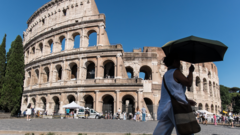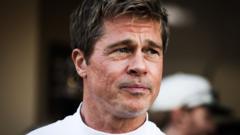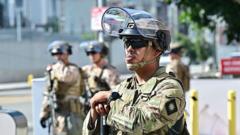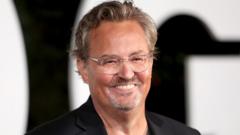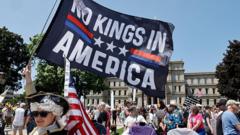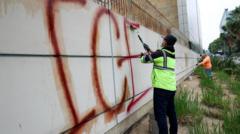This article explores the contrasting opinions on bicycle infrastructure in Los Angeles, examining its potential impact on transportation leading up to the 2028 Olympics.
**Can Bike Lanes Transform Los Angeles into a Cycling City?**
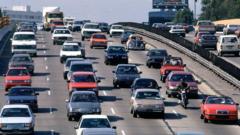
**Can Bike Lanes Transform Los Angeles into a Cycling City?**
As LA prepares for major sporting events, the city's car-dominated culture is facing a potential shift toward cycling and transit.
While Los Angeles is often characterized by its love for cars, recent initiatives are aiming to change that narrative as the city prepares for the 2026 World Cup and the 2028 Olympic Games. With approximately 460 square miles of sprawl, LA is infamous for its traffic congestion and reliance on automobiles, with just 7% of residents utilizing mass transit. However, the city is taking steps to promote a more bike-friendly environment through the "Twenty-eight by '28" transport plan, designed to enhance transit options ahead of the Olympic events.
Damian Kevitt, executive director of Streets Are For Everyone (Safe), sees an opportunity in Los Angeles’s climate, which is considered ideal for cycling. He advocates for the new bike lanes, believing that increased safety and connectivity will entice more Angelenos to commute via bicycle. Following the approval of a 2024 ballot measure, city officials are obligated to elevate bicycle infrastructure alongside creating more walkable areas.
Yet, not everyone is on board. Car-centric residents express concerns about how bike lanes could exacerbate traffic issues. Opposition highlights that similar initiatives elsewhere, like Toronto's controversial bike lanes, have led to complaints about congestion. Local resident Darin Drabing argues that the expected increase in bike lanes will create additional traffic woes near his business in Forest Lawn Cemetery.
At the same time, cyclists like Mimi Holt are encouraged by the changes, noting that improved infrastructure could help many more Angelenos transition away from car dependency. Holt, after years of avoiding biking due to safety concerns, returned to cycling and emphasizes the need for interconnected bike paths that could lead to significant shifts in commuting behaviors.
Mayor Karen Bass is optimistic about the city's transit transformation, pushing for a "transit first" approach during the upcoming Olympic Games. She acknowledges the ambition of establishing over 100 miles of bike lanes, though critics mention that progress with the planned projects seems slow. With federal aid from the Biden administration and ongoing negotiations for further funding, Bass remains committed to enhancing transit options while fostering a culture that embraces alternatives to car commuting.
However, skepticism persists among residents like Shivon Ozinga, who believe that the city’s car-centric culture may resist evolving within the limited timeline before the Games. While some envision a future where biking replaces car travel, others remain unconvinced, seeing the current state of LA transit as too entrenched in automobile reliance.
As Los Angeles navigates this critical juncture, the impending changes could either pave the way for a new transportation landscape or solidify the status quo, reflecting the complex relationship between lifestyle, environmental concerns, and urban planning in America’s second-largest city.
Damian Kevitt, executive director of Streets Are For Everyone (Safe), sees an opportunity in Los Angeles’s climate, which is considered ideal for cycling. He advocates for the new bike lanes, believing that increased safety and connectivity will entice more Angelenos to commute via bicycle. Following the approval of a 2024 ballot measure, city officials are obligated to elevate bicycle infrastructure alongside creating more walkable areas.
Yet, not everyone is on board. Car-centric residents express concerns about how bike lanes could exacerbate traffic issues. Opposition highlights that similar initiatives elsewhere, like Toronto's controversial bike lanes, have led to complaints about congestion. Local resident Darin Drabing argues that the expected increase in bike lanes will create additional traffic woes near his business in Forest Lawn Cemetery.
At the same time, cyclists like Mimi Holt are encouraged by the changes, noting that improved infrastructure could help many more Angelenos transition away from car dependency. Holt, after years of avoiding biking due to safety concerns, returned to cycling and emphasizes the need for interconnected bike paths that could lead to significant shifts in commuting behaviors.
Mayor Karen Bass is optimistic about the city's transit transformation, pushing for a "transit first" approach during the upcoming Olympic Games. She acknowledges the ambition of establishing over 100 miles of bike lanes, though critics mention that progress with the planned projects seems slow. With federal aid from the Biden administration and ongoing negotiations for further funding, Bass remains committed to enhancing transit options while fostering a culture that embraces alternatives to car commuting.
However, skepticism persists among residents like Shivon Ozinga, who believe that the city’s car-centric culture may resist evolving within the limited timeline before the Games. While some envision a future where biking replaces car travel, others remain unconvinced, seeing the current state of LA transit as too entrenched in automobile reliance.
As Los Angeles navigates this critical juncture, the impending changes could either pave the way for a new transportation landscape or solidify the status quo, reflecting the complex relationship between lifestyle, environmental concerns, and urban planning in America’s second-largest city.


